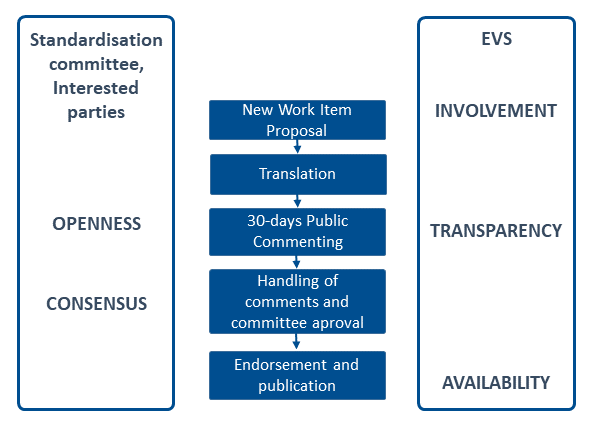Translation method
- European and international standards can be adopted by translation method as Estonian standards.
- The adoption by translation method can be initiated by any interested party.
- The text of a standard is translated into Estonian from the official languages of the organisation that published it; these languages include English, French, German (at the European level), and Russian (at the international level). Primarily, English texts are used for translations.
- The drafting process is described in guides EVS JUHEND 2 and EVS JUHEND 5 (see also guide EVS JUHEND 4).
How does the adoption by translation method work?
- To initiate the adoption of European or international standard as Estonian standard by translation method, you should submit a formal proposal.
- Upon approving the proposal, a translation draft is typically compiled by a committee’s expert group or experts registered at the Estonian Centre for Standardisation and Accreditation.
- The translation draft text is submitted to the Estonian Centre for Standardisation and Accreditation for conducting the commenting of the translation. A notification about the start of the commenting is be published in EVS Bulletin and the text of the standard draft is made available for reading and commenting in the comments portal of the Estonian Centre for Standardisation and Accreditation. The commenting lasts for 30 days.
- Once the commenting is over, a summary is made of the received comments/proposals and the received input is analysed.
- A translation draft that has achieved consensus in the committee is submitted to the Estonian Centre for Standardisation and Accreditation to be confirmed and published as a standard.
Stages of the adoption by translation method
What to take into account when translating?
- The process and formalities of the translation method are described in the following guides: EVS JUHEND 2, EVS JUHEND 5 and EVS JUHEND 4.
- When translating, the terms should be precise and the text unambiguous both in that particular document and in the field’s standards.
- The complete text of the standard must be translated.
- A national annex (NA) of an Estonian standard is drafted in case the standard to be adopted includes a relevant requirement.
- A standard adopted by translation method may include editorial changes, an international standard may also include technical modifications that must be clearly discernible in the text and referenced to in the foreword of the Estonian standard.

